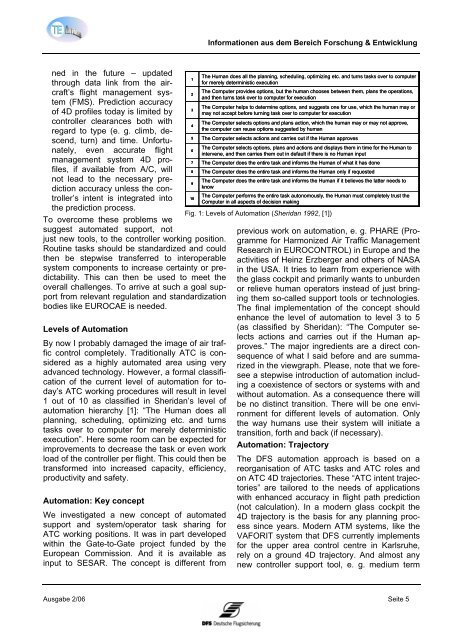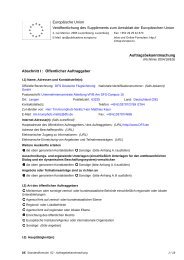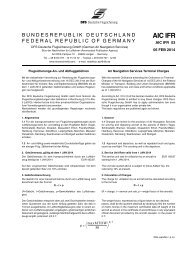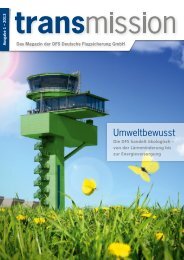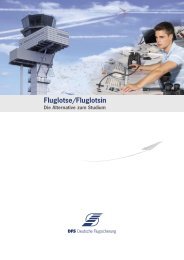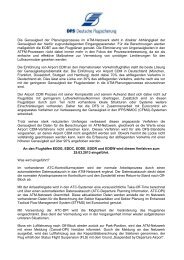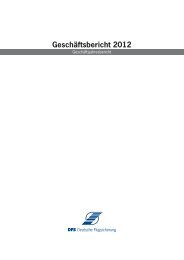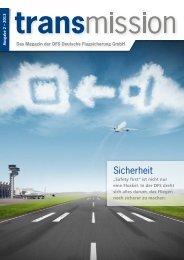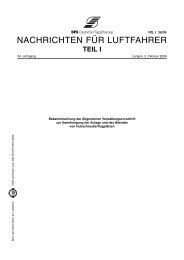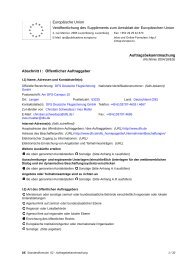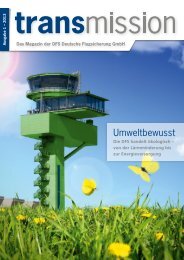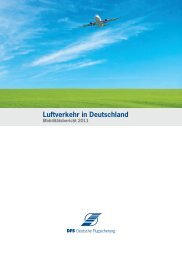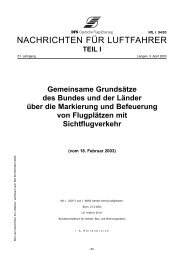Projekt MSP-DL - Deutsche Flugsicherung GmbH
Projekt MSP-DL - Deutsche Flugsicherung GmbH
Projekt MSP-DL - Deutsche Flugsicherung GmbH
Erfolgreiche ePaper selbst erstellen
Machen Sie aus Ihren PDF Publikationen ein blätterbares Flipbook mit unserer einzigartigen Google optimierten e-Paper Software.
ned in the future – updated<br />
through data link from the air-<br />
1<br />
craft’s flight management system<br />
(FMS). Prediction accuracy<br />
2<br />
of 4D profiles today is limited by<br />
3<br />
controller clearances both with<br />
regard to type (e. g. climb, de-<br />
4<br />
scend, turn) and time. Unfortu-<br />
5<br />
nately, even accurate flight<br />
6<br />
management system 4D profiles,<br />
if available from A/C, will<br />
7<br />
8<br />
not lead to the necessary prediction<br />
accuracy unless the con-<br />
9<br />
know<br />
troller’s intent is integrated into<br />
the prediction process.<br />
To overcome these problems we<br />
suggest automated support, not<br />
10<br />
just new tools, to the controller working position.<br />
Routine tasks should be standardized and could<br />
then be stepwise transferred to interoperable<br />
system components to increase certainty or predictability.<br />
This can then be used to meet the<br />
overall challenges. To arrive at such a goal support<br />
from relevant regulation and standardization<br />
bodies like EUROCAE is needed.<br />
Levels of Automation<br />
By now I probably damaged the image of air traffic<br />
control completely. Traditionally ATC is considered<br />
as a highly automated area using very<br />
advanced technology. However, a formal classification<br />
of the current level of automation for today’s<br />
ATC working procedures will result in level<br />
1 out of 10 as classified in Sheridan’s level of<br />
automation hierarchy [1]: “The Human does all<br />
planning, scheduling, optimizing etc. and turns<br />
tasks over to computer for merely deterministic<br />
execution”. Here some room can be expected for<br />
improvements to decrease the task or even work<br />
load of the controller per flight. This could then be<br />
transformed into increased capacity, efficiency,<br />
productivity and safety.<br />
Automation: Key concept<br />
We investigated a new concept of automated<br />
support and system/operator task sharing for<br />
ATC working positions. It was in part developed<br />
within the Gate-to-Gate project funded by the<br />
European Commission. And it is available as<br />
input to SESAR. The concept is different from<br />
Informationen aus dem Bereich Forschung & Entwicklung<br />
The Human does all the planning, scheduling, optimizing etc. and turns tasks over to computer<br />
for merely deterministic execution<br />
The Computer provides options, but the human chooses between them, plans the operations,<br />
and then turns task over to computer for execution<br />
The Computer helps to determine options, and suggests one for use, which the human may or<br />
may not accept before turning task over to computer for execution<br />
The Computer selects options and plans action, which the human may or may not approve,<br />
the computer can reuse options suggested by human<br />
The Computer selects actions and carries out if the Human approves<br />
The Computer selects options, plans and actions and displays them in time for the Human to<br />
intervene, and then carries them out in default if there is no Human input<br />
The Computer does the entire task and informs the Human of what it has done<br />
The Computer does the entire task and informs the Human only if requested<br />
The Computer does the entire task and informs the Human if it believes the latter needs to<br />
The Computer performs the entire task autonomously, the Human must completely trust the<br />
Computer in all aspects of decision making<br />
Fig. 1: Levels of Automation (Sheridan 1992, [1])<br />
previous work on automation, e. g. PHARE (Programme<br />
for Harmonized Air Traffic Management<br />
Research in EUROCONTROL) in Europe and the<br />
activities of Heinz Erzberger and others of NASA<br />
in the USA. It tries to learn from experience with<br />
the glass cockpit and primarily wants to unburden<br />
or relieve human operators instead of just bringing<br />
them so-called support tools or technologies.<br />
The final implementation of the concept should<br />
enhance the level of automation to level 3 to 5<br />
(as classified by Sheridan): “The Computer selects<br />
actions and carries out if the Human approves.”<br />
The major ingredients are a direct consequence<br />
of what I said before and are summarized<br />
in the viewgraph. Please, note that we foresee<br />
a stepwise introduction of automation including<br />
a coexistence of sectors or systems with and<br />
without automation. As a consequence there will<br />
be no distinct transition. There will be one environment<br />
for different levels of automation. Only<br />
the way humans use their system will initiate a<br />
transition, forth and back (if necessary).<br />
Automation: Trajectory<br />
The DFS automation approach is based on a<br />
reorganisation of ATC tasks and ATC roles and<br />
on ATC 4D trajectories. These “ATC intent trajectories”<br />
are tailored to the needs of applications<br />
with enhanced accuracy in flight path prediction<br />
(not calculation). In a modern glass cockpit the<br />
4D trajectory is the basis for any planning process<br />
since years. Modern ATM systems, like the<br />
VAFORIT system that DFS currently implements<br />
for the upper area control centre in Karlsruhe,<br />
rely on a ground 4D trajectory. And almost any<br />
new controller support tool, e. g. medium term<br />
Ausgabe 2/06 Seite 5


